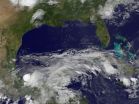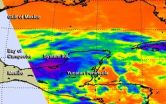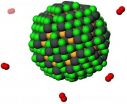(Press-News.org) NASA and NOAA satellites are gathering visible, infrared, microwave and radar data on a persistent tropical low pressure area in the southwestern Bay of Campeche. System 90L now has a 50 percent chance for development, according to the National Hurricane Center and continues to drop large amounts of rainfall over southeastern Mexico.
The Atmospheric Infrared Sounder (AIRS) instrument aboard NASA's Aqua satellite gathered infrared data on the developing low on June 5 at 18:59 UTC (2:59 p.m. EDT).
Basically, AIRS looks at the infrared region of the spectrum. In a spectrum, infrared light has a wavelength just greater than that of the red end of the visible light spectrum but less than that of microwaves. Looking at infrared light, instruments are able to detect temperature and AIRS gathered temperature information about the heights of the tops of the thunderstorms that make up System 90L (a tropical cyclone or developing low pressure area can consist of hundreds of thunderstorms).
AIRS data revealed that the tropical low had cloud-top temperatures near -63F (-52C). Cloud top temperatures that cold indicate thunderstorms strong enough with the potential to drop heavy rainfall, and the National Hurricane Center warned about flash flooding and mudslides in the Yucatan peninsula and southeastern Mexico.
The low has been hanging around the Bay of Campeche since June 2. When it developed it was an elongated and broad area of low pressure with a near zero chance of development. Today, June 6, that's changed.
At 1200 UTC (8 a.m. EDT) on June 6, System 90L was sitting in the Bay of Campeche, but has moved west of its position from earlier in the week. System 90L was located near 19.3 north latitude and 94.5 west longitude.
The National Hurricane Center (NHC) noted that shower and thunderstorm activity associated with System 90L has changed little in organization overnight from June 5 to June 6. NHC uses visible and infrared imagery from the two GOES satellites to monitor the changes in System 90L in addition to data from several NASA satellites.
NOAA's GOES-East satellite sits in a fixed orbit in space and captures visible and infrared imagery of all weather over the eastern U.S. and Atlantic Ocean. A visible image from GOES-East on June 6 at 7:30 a.m. EDT, showed developing System 90L's center is near the rounded area of clouds. The image was made by NASA/NOAA's GOES Project at NASA's Goddard Space Flight Center in Greenbelt, Md. System 90L is sitting off the coasts of the Mexican states of Veracruz and Tabasco.
The NHC Discussion noted that regardless of tropical cyclone formation, this disturbance could produce heavy rains, along with life-threatening flash floods and mud slides, over portions of southeastern and eastern Mexico during the next few days.
The Mexican Weather Service (MWS) noted in an advisory on June 6 that System 90L has the potential to bring rain to the states of Central, South and Southeast parts of the country, as well as in the Yucatan Peninsula. The MWS forecasts between 150 to 250 mm (~6 to ~10 inches) of rainfall for the state of Veracruz; between 75 to 150 mm (~3 to ~6 inches) for the Guerrero, Oaxaca, Puebla y Chiapas, and rainfall between 50 to 75 mm (~2 to ~3 inches) for México, Michoacán, Hidalgo, Morelos, Tabasco, Distrito Federal y Tlaxcala. For updated forecasts (in Spanish) from the MWS, visit: http://smn.cna.gob.mx.
INFORMATION:
Text credit: Rob Gutro
NASA's Goddard Space Flight Center END
Satellite sees System 90L dissipating over Mexico
2014-06-09
ELSE PRESS RELEASES FROM THIS DATE:
Scientists may have identified echoes of ancient Earth
2014-06-09
A group of scientists believe that a previously unexplained isotopic ratio from deep within the Earth may be a signal from material from the time before the Earth collided with another planet-sized body, leading to the creation of the Moon. This may represent the echoes of the ancient Earth, which existed prior to the proposed collision 4.5 billion years ago. This work is being presented at the Goldschmidt conference in Sacramento, California.
The currently favoured theory says that the Moon was formed 4.5 billion years ago, when the Earth collided with a Mars-sized mass, ...
Surgery prices are elusive
2014-06-09
Let's say you're buying a car. You have a wealth of data at your fingertips, from safety information to performance, to guide your decision.
The same is not as true in health care, especially if you're pricing procedures. A new study from the University of Iowa compared the cost of prostate cancer surgery at 100 hospitals throughout the United States. The quote for the procedure, the researchers found, varied from $10,100 to $135,000, a 13-fold range. (The average price was nearly $35,000, more than double the Medicare reimbursement.)
Only 10 of the hospitals that provided ...
New class of nanoparticle brings cheaper, lighter solar cells outdoors
2014-06-09
TORONTO, ON — Think those flat, glassy solar panels on your neighbour's roof are the pinnacle of solar technology? Think again.
Researchers in the University of Toronto's Edward S. Rogers Sr. Department of Electrical & Computer Engineering have designed and tested a new class of solar-sensitive nanoparticle that outshines the current state of the art employing this new class of technology.
This new form of solid, stable light-sensitive nanoparticles, called colloidal quantum dots, could lead to cheaper and more flexible solar cells, as well as better gas sensors, infrared ...
With distance comes greater wisdom, research finds
2014-06-09
If you're faced with a troubling personal dilemma, such as a cheating spouse, you are more likely to think wisely about it if you consider it as an observer would, says a study led by a professor at the University of Waterloo.
Professor Igor Grossmann, of Waterloo, and Professor Ethan Kross from the University of Michigan, asked study participants to reflect on a relationship conflict of their own or someone else's, such as a spouse's infidelity with a close friend, and think about the conflict in the first and third person. The findings will appear in an upcoming issue ...
Online marketing schemes can still lure in customers
2014-06-09
Despite warnings and legislation, online consumers may still be susceptible to post-transaction marketing schemes, according to Penn State researchers.
At least 40 percent of consumers who made an online purchase in a study bought an additional product, even though it offered no extra value, said Jens Grossklags, assistant professor of information sciences and technology.
"The focus of this study was to determine the likelihood that a consumer would accept an offer after they had already made a purchase," said Grossklags. "What stood out was the vast number of people ...
Seeing how a lithium-ion battery works
2014-06-09
CAMBRIDGE, Mass-- New observations by researchers at MIT have revealed the inner workings of a type of electrode widely used in lithium-ion batteries. The new findings explain the unexpectedly high power and long cycle life of such batteries, the researchers say.
The findings appear in a paper in the journal Nano Letters co-authored by MIT postdoc Jun Jie Niu, research scientist Akihiro Kushima, professors Yet-Ming Chiang and Ju Li, and three others.
The electrode material studied, lithium iron phosphate (LiFePO4), is considered an especially promising material for ...
Science and technology advances in microbial forensics needed to better prepare
2014-06-09
WASHINGTON – Much as human DNA can be used as evidence in criminal trials, genetic information about microorganisms can be analyzed to identify pathogens or other biological agents in the event of a suspicious disease outbreak. The tools and methods used to investigate such outbreaks belong to an emerging discipline known as microbial forensics, but the field faces substantial scientific and technical challenges, says a new report from the National Research Council. The report offers an initial set of research priorities for advancing the capabilities needed to make microbial ...
Specific protein may help beta cells survive in type 1 diabetes
2014-06-09
In the healthy pancreas of someone without type 1 diabetes (T1D), the hormone insulin (essential for turning food into energy) is produced, stored, and released in a normal "factory-like" process within pancreatic beta cells in response to glucose in the diet. Early in the course of T1D, however, excessive or pathologic stress in beta cells compromises their ability to properly secrete insulin, triggering a cascade of events ultimately contributing to the beta cell death. Over the past several years, JDRF-funded researchers have found evidence that beta cell stress may ...
55-year old dark side of the moon mystery solved
2014-06-09
The Man in the Moon appeared when meteoroids struck the Earth-facing side of the moon creating large flat seas of basalt that we see as dark areas called maria. But no "face" exists on farside of the moon and now, Penn State astrophysicists think they know why.
"I remember the first time I saw a globe of the moon as a boy, being struck by how different the farside looks," said Jason Wright, assistant professor of astrophysics. "It was all mountains and craters. Where were the maria? It turns out it's been a mystery since the fifties."
This mystery is called the Lunar ...
Tangled path of Alzheimer's-linked brain cells mapped in mice
2014-06-09
By studying laboratory mice, scientists at The Johns Hopkins University have succeeded in plotting the labyrinthine paths of some of the largest nerve cells in the mammalian brain: cholinergic neurons, the first cells to degenerate in people with Alzheimer's disease.
"For us, this was like scaling Mount Everest," says Jeremy Nathans, Ph.D., professor of molecular biology and genetics, neuroscience, and ophthalmology at the Johns Hopkins University School of Medicine. "This work reveals the amazing challenges that cholinergic neurons face every day. Each of these cells ...





